A single invasive pest outbreak can cost U.S. agriculture billions, but this week brings promising news: a newly EPA-approved biopesticide and breakthrough research on natural insect predators are poised to reshape pest control. As pest pressures intensify due to climate and urbanization, the industry faces a web of new regulations, technology, and health concerns.
The latest developments—from smarter EPA regulations to digital monitoring and eco-friendly strategies—offer safer, more effective, and sustainable answers for homes, businesses, and environments.
Regulatory Shifts: EPA and State Agencies Tighten the Rules
The EPA now requires pesticide applicators to consult dynamic online bulletins for site-specific mitigation, especially to protect endangered species. State agencies, like California, are tightening rodenticide rules, driving a shift toward reduced chemical use and demanding greater digital literacy and ongoing training among pest professionals.
Tech Innovations: Smarter, Safer Pest Management Hits the Market
AI-powered rodent monitoring and drone-based mosquito surveillance are being piloted in New York and Florida. IoT-enabled traps and digital diagnostics are becoming industry standards. North America’s pest control sector is projected to reach $44.3 billion by 2034, driven by investments in AI, biological controls, and non-toxic treatments. These technologies promise safer, more transparent, and responsive service.
Environmental and Public Health Impact: Eco-Friendly Solutions Gain Ground
Research shows native insect predators like the spined soldier bug and mantises are effective against invasive pests such as the spotted lanternfly. Integrated pest management (IPM), sanitation, and customer service are prioritized, with regulatory changes and CDC guidance favoring eco-friendly, non-chemical solutions, especially in sensitive environments like schools.
Deep Analysis: What This Week’s Pest Control Developments Mean for You
Regulatory agencies are crafting dynamic, protective standards for health and the environment. Technology is enabling data-driven prevention and accountability. Eco-friendly alternatives like leveraging native predators are gaining traction. The industry’s future will be defined by adaptive regulation, technology, and sustainable solutions, requiring ongoing training for professionals and offering safer, more effective pest management for consumers.
Takeaways: Staying Ahead in U.S. Pest Control
- Innovation is accelerating, driven by climate, regulation, and technology.
- EPA’s digital bulletins and mitigation “menus” make compliance smarter, but more demanding.
- AI-powered and IoT-enabled solutions are mainstream for data-backed, safer management.
- Eco-friendly strategies, including supporting natural predators, are becoming best practice.
- Staying informed and proactive is essential for all stakeholders.
Memorable Quotes from the Week in Pest Control
“Leading players are investing heavily in biological control, AI-powered monitoring, and non-toxic treatments to meet regulatory standards and consumer preferences.” — Allied Market Research
“The EPA is increasing efforts to make sure pesticide impacts are minimal, especially for species that have been identified as an endangered species.” — NCIPMC Regulatory Summary
Learn More
- OpenPR Pest Control Market Report
- PCT Online June 2024 Issue
- NCIPMC EPA Regulatory Update
- ScienceDaily: Natural Predators for Spotted Lanternfly
Stay ahead—subscribe for weekly updates on U.S. pest control trends, or share this article with your network.
- Bed Bug Surge 2025: How to Detect, Prevent, and Safely Eliminate Infestations in Top U.S. Cities - June 18, 2025
- Asian Needle Ants Invade US Homes: 2025 Guide to Identification, Risks, and Effective Control - June 11, 2025
- New World Screwworm Alert: How US Livestock Owners Can Prevent Outbreaks and Protect Herds [Summer 2025 Update] - June 8, 2025
